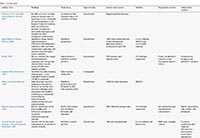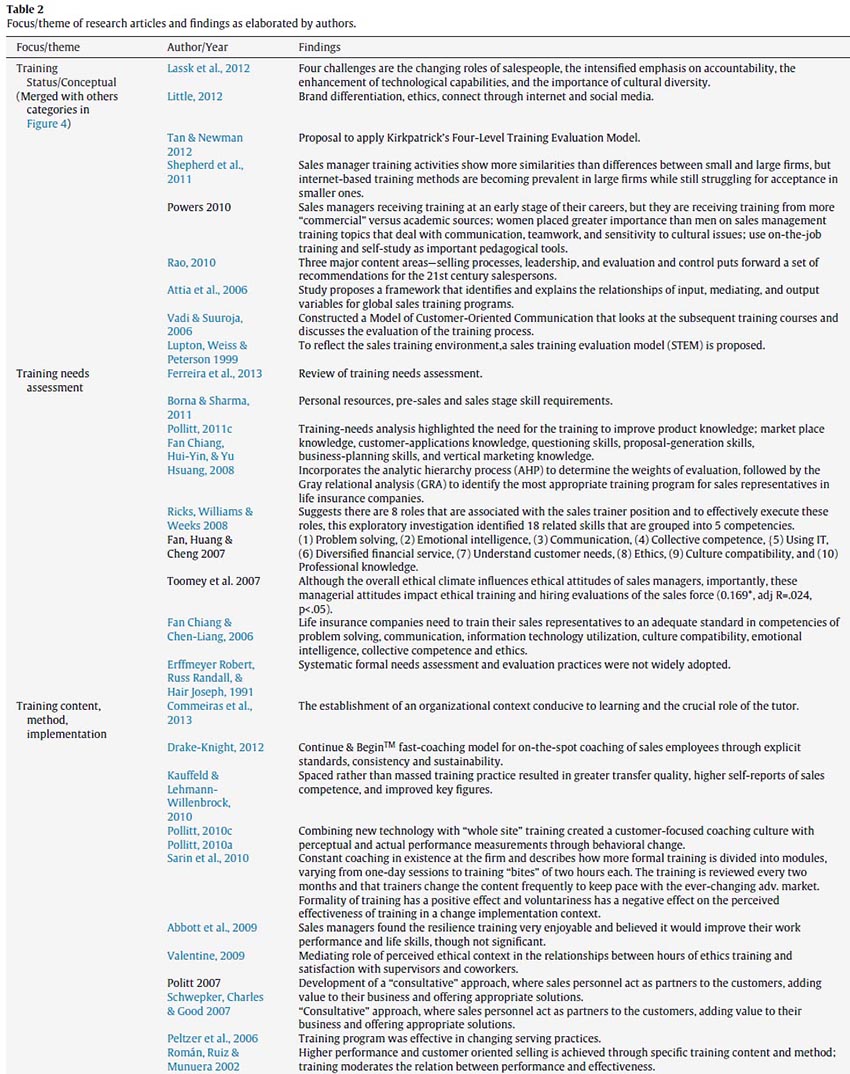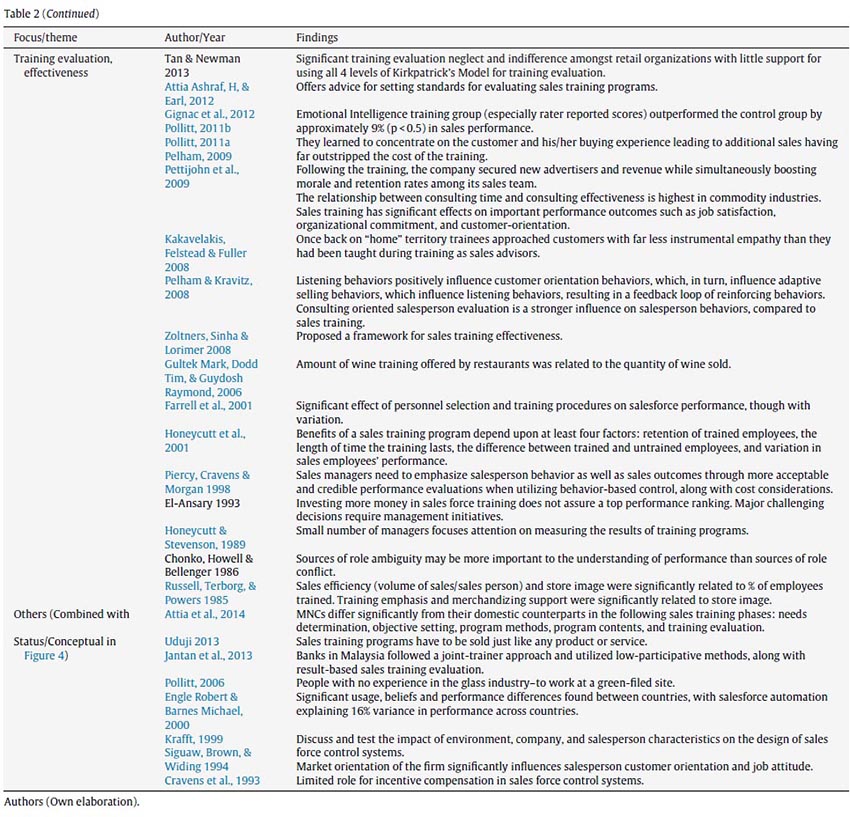Serviços Personalizados
Journal
Artigo
Indicadores
-
 Citado por SciELO
Citado por SciELO
Links relacionados
-
 Similares em
SciELO
Similares em
SciELO
Compartilhar
Journal of Economics, Finance and Administrative Science
versão impressa ISSN 2077-1886
Journal of Economics, Finance and Administrative Science vol.20 no.38 Lima jun. 2015
http://dx.doi.org/10.1016/j.jefas.2015.01.001
ARTICLE
Sales training: a state of the art and contemporary review*
Formación en ventas: una revisión puntera y contemporánea
Vijay Lakshmi Singh1, Ajay K. Manraib2, Lalita A. Manraib3*
Indian Institute of Management, Ahmedabad, India b University of Delaware, Newark, USA.
ABSTRACT
Organizations of today face numerous challenges, and training their sales force is definitely high on its agenda. This paper endeavors to contribute to the sales training field by providing a comprehensive stateof- the art and contemporary review through the study of publications in sales training research in the last 30 years (1985-2014). The specific objectives of the review are to study the chronological trends and structural distribution of sales training research in terms of the research type, research focus, methods, research themes and other issues such as methodology, analytical techniques, geographical region etc. Findings of 56 articles on sales training research published in the last three decades are analyzed and directions for future research are identified.
Keywords: Sales, Training, Assessment, Implementation, Evaluation, Performance.
RESUMEN
Las organizaciones actuales se enfrentan a numerosos retos, siendo prioritaria en su agenda la formación de su fuerza de ventas. El presente documento pretende contribuir en este campo, mediante la aportación de una revisión amplia, vanguardista y contemporánea del estudio de las publicaciones sobre la investigación de la formación en ventas durante los últimos 30 años (1985-2014). Los objetivos específicos de la revisión son el estudio de las tendencias cronológicas y la distribución estructural de la investigación de la formación en ventas, en términos de tipo, objetivo y temas de la investigación, así como otras cuestiones tales como la metodología, las técnicas analíticas, la región geográfica, etc. Se analizan los hallazgos de 56 artículos sobre investigación de la formación en ventas, publicados durante los últimos treinta años, y se identifican las orientaciones de la investigación futura.
Palabras clave: Ventas, Formación, Valoración, Implementación, Evaluación, Desempeño.
1. Introduction
Organizations of today face numerous challenges, and training their sales force is definitely high on the agenda of most organizations (Rao, 2010). The increasing interest that firms have been showing over recent years in employees and in practices related to their management, especially training, can be explained by the general acceptance of the fact that human resources and organizational knowledge are, at present, two of the main sources of sustainable competitive advantages for the company.
Sales training is a challenge to organizations, big or small, national or multinational, manufacturers or service providers especially amidst today’s rapidly changing global economy. Organizations are spending millions of dollars on training employees, and sales training takes a significant portion of that budget (Tan & Newman, 2013). However, sales training programs seem to enjoy a lot of advantages despite their costs. Sales training involves a systematic attempt to understand, describe, and transfer "good selling practices" to sales personnel. Through sales training programs, sales personnel may actually learn to perform more effectively and more quickly. Research suggests that training may increase the salesperson’s knowledge base and skill level, resulting in higher performance (Aragón-Sánchez, Barba-Aragón, & Sanz-Valle, 2003).
Anything that the organization can do to facilitate the sales training process through mentoring, role playing, observation, etc., should be better than no training at all and hence the need and justification for training (Attia Ashraf, Jantan M., Atteya, & Fakhr, 2014). Moreover, the motivation to receive training is also extremely high among salespeople, sales managers, and sales executives, leading the American Society for Training & Development to conclude that «the timing for sales training has never been better» (Lassk, 2012). Arguing on the same line, sales training research is hence also of interest to academicians and practitioners toward enriching and advancing the sales training knowledge base amidst continuous business challenges and opportunities.
This review paper consists of seven sections. In the next section we provide an overview of the sales training research and identify that a comprehensive review of sales training research does not exist until date to the best of our knowledge. We specifically identify various objectives of the study in terms of analysis of chronological trends and an understanding of relative emphasis on various aspects of sales training. The third section of our paper discusses the objectives and methodology of our research. In the fourth section we report the results of our analysis of 57 sales training research articles published in the last three decades (1985-2014). The fifth section provides highlights of some interesting sales training studies. In the sixth section our findings are discussed and also overall conclusions are drawn. The seventh and final section of the paper identifies directions for future research.
2. Sales training research: An overview
Evidence of the fact that organizations are devoted to sales training may be found in the investments companies make in sales training. Of these training expenditures, research has concluded that sales training represents the largest portion of total training expenditures. Selling is a problem-solving mission and training helps salesmen to understand, anticipate and exceed customer needs (Pollitt, 2012). According to Harris (2001), as cited in Pettijohn, Pettijohn and Taylor (2009), sales representatives need "grooming" to succeed and this grooming is an investment that is made by the firm and the manager in the form of training and coaching. It seems that the general sentiment is that if one has "some level of talent", then sales training can be instrumental in helping convert that talent into positive results. Training can be defined as a planned program within the organization that endeavors to bring about relatively permanent changes in employee knowledge, skills, attitudes, and behavior. In the present context, training may improve sales performance (and company profits) by increasing productivity, improving morale, reducing turnover, improving customer relations, and improving management of time and territory (Farrell et al., 2001).
Interest in the topic of sales training has been increasing over the years in parallel with its rising practice as evident from the splurge in sales training publications by almost three times in the past decade as compared to the end of the last century. However, the bulk of these publications are non-academic and in terms of research the progress has been slow, with only 23 peers reviewed sales training journal articles during 1980, 40 during 1990 and 66 during the last decade as per the computerized database search.
The American Society for Training and Development divides the major sales training methodologies into two categories, namely, self-study (i.e., readings, pre-workshop assignments, and programmed instruction) and workshops (i.e., lecture, discussion, on-the-job training, case study, and role plays). It has been suggested that organizations should attempt to use a combination of workshop methodologies in conjunction with some self-study methodologies (Vadi & Suuroja, 2006).
Further, the content of training for salespeople can be categorized into four as described by Hopkins (1978) involving: (a) product knowledge, (b) company knowledge, (c) market/industry awareness, and (d) selling techniques and related topics (Farrell et al., 2001). The nature of a typical sales training programs also varies depending upon if it is standardization (i.e., common to all salespeople), top-down (i.e., management decides), mandated (i.e., non-voluntary) structured (i.e., formal and centralized), in a classroom setting (by in-house or outside experts) (Sarin, Sego, Kohli, & Challagalla, 2010).
According to Aragón-Sánchez et al. (2003) the success of training depends on the correct execution of the steps of sales training process: previous analysis of training needs, development and implementation of an adequate training plan and evaluation. Training needs analysis is recognized as one of the first important "before" contributions to training effectiveness. A thorough needs analysis takes into account the individual differences of trainees, the organizational climate and objectives, and the characteristics of the task(s) to be learned. This information is then used to determine both the method and content of training.
It is worth mentioning that unlike what many articles have cited, training effectiveness is different from training evaluation. Training effectiveness is the study of the individual (personality traits, attitudes, abilities, demographics, experience, and expectations, self-efficacy, goal orientation, and motivation), organizational (climate for learning, history, policies, trainee selection technique, and trainee notification process) and training (instructional style, practice, and feedback), characteristics that influence the training process before, during, and after training (Álvarez et al., 2004). However, training experts typically study training effectiveness variables from the perspective of evaluation. Four of the five effectiveness models (Baldwin & Ford, 1988, Holton 1996; 2003, Tannenbaum et al., 1991, as cited in Alvarez, 2004) found in the literature focus primarily on one evaluation measure, transfer performance as the measures of learning.
Training evaluation, on the other hand, is the measurement of a training program’s success or failure with regard to content and design, changes in learners, and organizational payoffs. The evaluation techniques used to assess these depend on the evaluation model chosen, as four different models have been proposed. The first model, Kirkpatrick’s four dimensional measurement typology (i.e., reactions, learning, behavior, results) is, perhaps, the simplest and most common method for understanding training evaluation and the most frequently cited technique. This model was subsequently modified and advanced by other researchers, such as Alliger and Jantan (1989) who augmented the framework for training criteria based on Kirkpatrick’s model dividing training reactions into affective and utilitarian reactions, and learning into post-training measures of learning, retention, skill demonstration. In the second model, Tannenbaum et al. (1993) expanded on Kirkpatrick’s typology by adding post-training attitudes and dividing behavior into two outcomes for evaluation: training performance and transfer performance. A third evaluation model by Holton (1996) included three evaluation targets: learning, transfer, and results. Reactions were not a part of Holton’s model because reactions are not considered a primary outcome of training; rather, reactions are defined as a mediating and/or moderating variable between trainees’ motivation to learn and actual learning. The fourth and final evaluation model was provided by Aquinis and Kraiger (2009). This model emphasizes three multidimensional target areas for evaluation: training content and design (i.e., design, delivery, and validity of training), changes in learners (i.e., affective, cognitive, and behavioral) and organizational payoffs (i.e., transfer climate, job performance, and results) (Álvarez et al., 2004).
Previous reviews of literature have revealed the predominance of training evaluation studies in sales training research. For example, in the article focusing on sales trainers, Ricks, Williams, & Weeks (2008) identified only three studies on training needs/assessment, two studies on the content and implementation of training, while seven articles on training evaluation during 2000- 2005. There is need to understand if the relative emphasis on these major "themes" of sales training research, namely training needs assessment, content and implementation, and training evaluation has changed in the recent years. Further, apart from the themes of sales training research, there is also need to understand the relative emphasis on various types of studies (qualitative, quantitative, and conceptual research) as well as on focus of the sales training studies (academic, practitioners, and both). There are several other issues related to sales training research that need to be tracked. These include sales training research methodology, analytical techniques used in sales training research, sales training research by geographical region etc. To the best of our knowledge a comprehensive research review addressing all these issues related to sales training research does not exist at present. Our research presents a state of the art, contemporary, and comprehensive review of the sales training research field. The specific objectives of our research are to study various structural issues in the domain of sales training in terms of chronological trends, relative emphasis on type of sales training, focus of sales training, and themes of sales training and other issues.
3. Objectives and methodology of review
Recent trends in the personal selling environment, such as advances in technology, customer relationship management, and globalization have placed a premium on training programs designed to develop knowledgeable and effective sales managers. Firms now recognize that enhancing a sales manager’s working knowledge through training can be a source of a firm’s competitive advantage. Indeed, there is evidence that employee intellectual capital constitutes up to 75 percent of a firm’s total balance sheet (Powers, DeCarlo, & Gupte, 2010). Given the increased focus on developing managers’ knowledge and recent technological advances in ways to deliver information over the past decade, there is a need for understanding the current role and positioning of sales manager training (Ricks, Williams, & Weeks, 2008). Despite its strategic importance, the topic of sales management training remains one of the most neglected areas in the personal selling and sales management literature. The relative absence of attention to sales manager training practices is surprising because training is considered one of the most taxing as well as pervasive methods for not only enhancing individual productivity but also communicating organizational goals to new personnel (Powers et al., 2010).
The importance of sales training already identified, it should also be known that sales training research has had long roots, with the oldest peer reviewed article dating back to the year 1910. However, sales training research has been sluggish as revealed by the quantity of sales training research with only about 240 peers reviewed journal articles over a span of 100 years. In the context of reviews or synthesizing papers, such as meta-analysis, the situation is worse due to the prevalence of a widely varying type of studies with diverse research focus and approaches.
In the past, Baldwin and Ford (1988) have reviewed the transfer of training literature; Alliger and Janak (1989) reviewed Kirkpatrick’s levels of training criteria in published studies, while Alliger, Tannenbaum, Bennett, Traver, & Shotl& (1997) provided a meta-analysis on training criteria; Álvarez, Salas and Garofano (2004) reviewed studies on the sales training effectiveness; Cron William, Marshall Greg, Singh, Spiro Rosann, & Sujan (2005) looked at the trends in salesperson selection, training, and development. In the recent years, only Attia, Honeycutt and Jantan (2006) have put forward a review of studies dealing with sales training at the global level. Aragón-Sánchez, Barba-Aragón and Sanz-Valle (2003) analyzed sales training studies in general in terms of their business results. Till date, none have generated a holistic review of sales training research and moreover there is a need to analyze and review recent studies on sales training.
Golterman (2000) cited a Gartner Group study that indicated that the four most important emerging salesperson skills are collaboration, relationship management, as well as finance, business, and consultative skills (Pelham, 2009). Also as increased emphasis on learning at the organizational and individual level is broadening and subsequently changing the role and positioning of training over the past decade and given that the demands of the sales role have changed, it follows that the training salespeople receive is changing, as well (Cron et al., 2005, Ricks et al., 2008). Hence, it would be worthwhile to have an update on the latest trends, interests and findings of recent sales training research and examine if this stream of research has progressed as previously suggested.
Thus, the present paper endeavors to contribute to the sales training field by providing a state-of-the art and contemporary review through the study of recent publications in sales training. The specific objectives of the review are to study the structural trend in the domain of sales training in terms of the research type, method, focus adopted as well as the research content and findings.
To review and integrate the literature on sales training, a literature search was conducted for empirical investigations of sales training that were published during the thirty years prior to this writing, that is, 1985 to 2014. The search was carried out through computer on the Ebsco Discovery Service and Academic Search Premier database and included empirical as well as conceptual/review studies published from the following journals: Journal of Personal Selling & Sales Management (6 articles, highest number of articles from a single academic journal), Marketing Intelligence & Planning, Marketing Management Journal, Industrial Marketing Management, Personnel Psychology, Journal of Management, Services Marketing Quarterly, International Journal of Management, Industrial & Commercial Training, Cross Cultural Management, American Journal of Business, IUP Journal of Soft Skills, Journal of European Industrial Training, Journal of Business & Industrial Marketing, E-Journal of Applied Psychology, Journal of Strategic Marketing, Journal of Vocational Education & Training, International Journal of Training & Development, Journal of Retailing & Consumer Services, Journal of Psychology in Africa, International Journal of Hospitality Management. In addition, papers were also included from the practitioner focused Human Resource Management International Digest.
The initial search resulted in more than 4 500 articles since the early 1900 s in the sales training literature. However, through the filter of peer and expert interviews; and then eliminating articles that were not in English language and those that were book reviews published in journals and some which had misleading titles and hence were not dealing with sales training, and finally applying the time frame filter of 1985-2014, a total of 56 articles (see Table 1) were included for the review of recent sales training research.
4. Sales training research analysis
4.1. Sales training research trends
Chronologically speaking, the interest in sales training research has exponentially risen in the last decade (2005-2014). Although the trend in the number of publications in the past two decades (1995-2004 and 1985-1994) was flat, they increased by a factor of six during 2005-2014. Thus, the last decade, 2005-2014 accounted for nearly 75% of the articles published in the past 30 years (1985- 2014). In this growth period of the most recent decade (2005-2014) there were 42 articles published, which is six times more than the number of articles published in each of the previous two decades (1985-1994 and 1995-2004).
4.2. Types of sales training research
In terms of the research design elements, our review reveals that qualitative studies consisted of 13 articles, quantitative studies consisted of 32 articles (such as Attia et al., 2014, Jantan, Asri Honeycutt, & Earl, 2013; Tan & Newman, 2013), and theoretical/ conceptual contributions consisted of 11 articles (Little, 2012; Attia et al., 2006 and Vadi & Suuroja, 2006). However, it should be noted that of the qualitative studies, actually only few of them are research based with concrete research contributions (Fan Chiang & Chen-Liang, 2006 and 2007; Ricks, Williams & Weeks, 2008; Kakavelakis, Felstead & Fuller, 2008), the rest being practitioner oriented case-narratives (Drake-Knight, 2012; Pollitt, 2006, 2007, 2010, 2011, 2012).
4.3. Sales training research methodologies
Further, the article reviews indicate that majority of the sales training research is being carried forward through questionnaire based survey method (15 articles such as Shepherd, Gordon, Ridnour, Weilbaker, & Lambert, 2011; Powers et al., 2010; Sarin et al., 2010; Kauffeld & Lehmann-Willenbrock, 2010; Toomey et al., 2008; and Gultek Mark, Dodd Tim, & Guydosh Raymond, 2006), followed by case studies (Ricks, Williams & Weeks, 2008; Little, 2012; and Pollitt, 2006, 2007, 2010, 2011, 2012). Very few studies are following the qualitative path based on interviews (Fan Chiang & Chen-Liang, 2006; 2007) and one on participant observation method (Kakavelakis, Felstead & Fuller, 2008). However, the point is that despite being pointed out by academicians in the past, value of experimental research in sales training has not progressed adequately. Only two experimental studies (Gignac, Harmer, Jennings, & Palmer, 2012 and Peltzer, Ramlagan & Gliksman, 2006) were found.
4.4. Analytical techniques used in sales training research
The studies included in our review used a wide variety of analytical techniques, ranging from sophisticated statistical tool use such as Structural Equation Modeling (Sarin et al., 2010; Pelham, 2009; Pelham & Kravitz, 2008), Multiple Regressions (Toomey et al., 2008; Valentine, 2009) and Factor Analysis (Gultek Mark, Dodd Tim, & Guydosh Raymond, 2006 and Abbott, Klein, Hamilton, & Rosenthal, 2009) and Bivariate/Univariate Analysis (Gignac et al., 2012; Powers et al., 2010) to qualitative techniques such as Delphi (Fan Chiang & Chen-Liang, 2006) and content analysis (Kakavelakis, Felstead & Fuller, 2008).
In terms of sample size variation, the samples included in the studies reviewed varied from 10-12 respondents for interviews, between 20-50 respondents in experiments and between 64 to 828 respondents in the case of surveys.
4.5. Focus of sales training research
Looking at the focus of studies reviewed, it was found that majority of the studies (25 articles) had a practitioner focus, while about another half (22 articles) having research focus. The remaining nine articles had a common focus that is being relevant for both practitioners and academicians.
4.6. Sales training research by geographical region
Of the total 41 articles reviewed, the majority of the studies are European (11 articles, e.g., Román, Ruiz & Munuera, 2002), followed by USA (11 articles, e.g., Tan & Newman, 2013), and few are Asian (3 articles, e.g., Fan Chiang, Hui-Yin, & Yu Hsuang, 2008), Australian (2 articles, e.g., Gignac et al., 2012) and in other regions. However, it should be noted that in term of pure research papers, of the 11 European studies in UK, Germany and Soviet Russia, only two of them qualify as being qualitative (Schwepker, Charles & Good, 2007 and Kakavelakis, Felstead & Fuller, 2008).
4.7. Themes of sales training research
According to Aragón-Sánchez (2003) the success of training depends on the correct execution of the steps of sales training process: previous analysis of training needs, development and implementation of an adequate training plan and evaluation and these themes have been variously investigated in the field of sales training research. Hence, finally looking at the review sample from the point of research theme, it is concluded that as compared to training assessment studies, research related to training implementation and evaluation has been up on the charts, with 12, 18 and 9 studies focused on training implementation, evaluation and assessment, respectively. The rest of the research reviewed (17 articles) can be classified as studies on the status/update of sales training (Little, 2012 and Powers et al., 2010) or other conceptual/ theoretical studies.
4.8. Sales training research: Findings by topic focus
The current section reviews the articles according to their content and findings, and classifies them into five types of studies: Status/conceptual, Assessment, Training/Implementation, Evaluation and others (see Table 2).
4.9. Assessment
The sales literature has responded to the increasing importance and criticism of training by focusing more attention on training assessment. In the latter half of the past decade, this literature has examined various aspects of training assessment e.g., Ricks, Williams and Weeks (2008) identified 8 roles, 18 skills grouped into 5 competencies that are associated with the sales trainer position; Toomey et al. (2008) emphasizes the important role of both formal control and significant others in creating an ethical sales force).
4.10. Training/Implementation
Numerous studies have focused on sales training content, e.g., Valentine (2009) posits to the mediating role of perceived ethical context in the relationship between hours of ethics training and satisfaction with supervisors and coworkers; Abbott et al. (2009) suggests sales managers believed very much that resilience training would improve their work performance and life skills. An emerging critical factor in the sales processes is the development and maintenance of long-term business relationships. As emotions play a crucial role in inter-personal relationships, the case for emotional intelligence in the sales processes may be argued as being important. Through an experiment design, Gignac et al. (2012) reveal emotional intelligence training group outperforming the control group by approximately 9% (p < 0.05) in sales performance. In the context of training delivery e.g., Kauffeld and Lehmann-Willenbrock (2010) found spaced rather than massed training practice resulting in greater transfer quality, higher selfreports of sales competence, and improved performance figures; while, formality of training has a positive effect and voluntariness has a negative effect on the perceived effectiveness of training in a change implementation context (Sarin et al., 2010). Recently, Commereiras et al. (2013) suggest the establishment of an organizational context conducive to learning and the crucial role of the tutor for successful training programs.
4.11. Evaluation
Organizations have learned to place their personnel selling skills as an essential contributor to both business success and survival. They know that their business is now defined by customer relationships and value-adding provided by their sales force. For their sales personnel to become successful in their jobs, sales training for these individuals has become necessary and essential. Despite spending thousands of dollars training their sales force every year, organizations often fail to follow through in evaluating the effectiveness of their training programs, thereby not allowing corrective actions to improve to take root. Without evaluating sales training effectiveness, organizations would not be able to make the necessary revision and renewal efforts to their sales training programs so that training can continuously be effective, accountable and significant to their organizations. Failing to evaluate, retail organizations could be spending considerable amount of time and resources continually on ineffective training programs perpetuating unimpressive sales force performances and contribution to their organizations.
Hence, the effects of various training topics have been assessed on a variety of outcomes, such as salesperson behaviors, attitudes, and performance (e.g., Pettijohn, Pettijohn & Taylor, 2009, Pelham & Kravitz, 2008); consulting effectiveness (Pelham, 2009); and their financial impact on the firm sales (Gultek Mark, Dodd Tim, & Guydosh Raymond, 2006). For example, Tan and Newman’s study (Tan & Newman, 2013) essentially utilized Kirkpatrick’s Four-Level Training Evaluation Model (Donald Kirkpatrick, 1994) to examine whether the interrelationships among its four levels of training evaluation (reaction, learning, behavior change, and organizational outcomes) are applied in determining training effectiveness.
4.12. Status/Conceptual
These studies have introduced ideas for enriching future research, like, Lassk (2012) examine four challenges currently facing the sales force —changing roles of salespeople, increased emphasis on training accountability, enhanced technology capabilities, and increasing cultural diversity— and the research gaps these challenges raise in the design, content, delivery, and evaluation of training. Rao (2010) puts forward a set of recommendations for the 21st century salespersons, while, Attia et al. (2006) proposed a framework that identifies and explains the relationships of input, mediating, and output variables for global sales training programs. Vadi and Suuroja (2006) constructed a Model of Customer-Oriented Communication that looks at the subsequent training courses and discusses the evaluation of the training process. On the other hand, status/update studies on sales training, such as Little (2012) identify brand differentiation, ethics, and connecting through internet and social media as important factors in sales training in the current business environment. Shepherd et al. (2011) reveal that sales manager training activities show more similarities than differences between small and large firms, but internet-based training methods are becoming prevalent in large firms while still struggling for acceptance in smaller ones. Similarly, Powers et al. (2010) have put forward a detailed study on various aspects of sales training.
Gartner Group study indicated that the four most important emerging salesperson skills are collaboration, relationship management, as well as finance, business, and consultative skills (Golterman, 2000; Pelham, 2009). In view of the increasing emphasis on coaching and consultative behavior, this review points toward the increasing focus of researchers on such topics, e.g., during 2006-2014, 6 articles were found that dealt with coaching and consultative behavior, e.g., Pelham (2009), Pelham and Kravitz (2008), Schwepker, Charles and Good (2007) and Pollitt (2007, 2010, 2012).
The practitioners have suggested sales training as a waste of energy and resources unless it is made sustainable and hence advocate sustainability through local coaching and performance management to keep the momentum up and the training alive (Drake-Knight, 2012). Pollitt (2012) also points toward constant coaching and division of more formal training into modules. He further strongly posits improvements in customer service through focus on ethics and customer orientation and development of a "consultative" approach, where sales personnel acts as partners to the customers, adding value to their business and offering appropriate solutions. It was found that following the training, new advertisers and revenues were secured while simultaneously boosting morale and retention rates among its sales team. Table 2 provides a chronological list of the research studies included in our review and provides details of authors, year of publication, major findings, topic of focus, type of study, sample/context, dependent variables, and independent variables.
5. Highlights of some interesting sales training studies
In this review we also point out some studies worth mentioning in terms of context and content of study.
Attia et al. (2014) examine similarities and differences of current state of initial sales training practices of both domestic and multinational corporations in Egypt. They conclude that MNCs differ significantly from their domestic counterparts in the following sales training phases: needs determination, objective setting, program methods, program contents, and training evaluation.
Shepherd et al. (2011) examined practices of and differences between small and large organizations (based on sales force size) as they relate to the training of sales managers, demonstrating sales training activities showing more similarities than differences between small and large firms, but internet-based training methods are becoming prevalent in large firms while still struggling for acceptance in smaller ones.
Borna and Sharma (2011) view acting skills to have potential in sales training through a series of steps to be taken by the salespeople in order to perform their roles effectively self exploration, preparation before entering the stage of selling, on-stage performance, and self evaluation.
Gignac et al. (2012) based on data from 50 Australian resident pharmaceutical sales representatives, examined statistically the efficacy of an emotional intelligence training program on sales performance and emotional intelligence in a group of salespeople using an experimental, repeated measures/between-groups design. They found that the rater-reported emotional intelligence (EI) correlated with sales performance at r = 0.32 and the training group outperformed the control group by approximately 9 per cent (p < 0.05) in sales performance.
Abbott et al. (2009) aimed to evaluate whether online resilience training, would improve the psychological health, wellbeing and work performance of sales managers from an Australian industrial organization. Sales managers found the resilience training very enjoyable and believed it would improve their work performance and life skills.
Valentine (2009) found a mediating role of perceived ethical context in the proposed relationships between hours of ethics training and satisfaction with supervisors and coworkers, suggesting organizational leaders for using ethics training to institutionalize an ethical environment in sales organizations. Such efforts could yield greater employee satisfaction for supervisors and coworkers.
Sarin et al. (2010) suggest that formality of training has a positive effect and voluntariness has a negative effect on the perceived effectiveness of training in a change implementation context. The findings provide empirical support to the call by Cron et al. (2005) for more customized and individualized sales force training programs.
Kauffeld and Lehmann-Willenbrock (2010) compared spaced and massed training using behavioral and outcome criteria showing spaced rather than massed training practice resulting in greater transfer quality, higher self-reports of sales competence, and improved key figures.
Kakavelakis, Felstead and Fuller (2008) based on participant observation examined the training of sales advisors in a large chain of private fitness clubs. It shows that although the training course taught trainees how to control and enchant customers, once back on "home" territory trainees approached customers with far less instrumental empathy than they had been taught.
Toomey et al. (2008) in their study toward responsible sales in the context of alcohol selling found that sales manager’s ethical attitudes are found to both directly and indirectly impact the ethical behavior of the sales force.
6. Discussion and conclusions
Sales training studies from the past thirty years analyzing the influence of training on business results have been compiled, classified and analyzed. There is relatively very little research in this field and our review study makes several important contributions to the theory and practice of sales training.
First, our analysis reveals that although the studies are very heterogeneous and it is difficult to generalize, most of them conclude that training positively affects productivity, quality, and financial results, and that different types of training have different impacts on business results. Further, our review suggests that advancements have been made that help us understand better the design and delivery of training in organizations, with respect to theory development as well as the quality and quantity of empirical research. We know more about factors that influence training effectiveness and transfer of training.
Second, our specific findings related to various aspects of sales training research are discussed. The number of publications in the sales training research has grown exponentially in the last decade (2005-2014) as compared to the previous two decades (1985-1994 and 1995-2005, see Figure 1). The quantitative studies dominate (57%) compared to qualitative studies (23%) and conceptual studies (20%) as shown in Figure 2. As regards the focus of sales training research, it was found that a majority of studies (45%) had a practitioner focus, followed by academic focus research (39%) and the remaining 16% of the research had both academic and practitioner focus (Figure 3). Findings of our review reveal that the dominant theme in the sales training research was training evaluation (32%) followed by training implementation and content (22%), needs assessment (16%), Miscellaneous other themes constituted the remaining 30% of research (Figure 4). The dominance of sales training evaluation theme is consistent with the findings of past reviews. For example, Rick et al. (2008) found that studies with evaluation as the theme of research were three and half times those on needs assessment and about two and half times those on implementation. Overall thus it can be concluded that much of the sales training research is practitioner focus, quantitative studies with evaluation of sales training as the main emphasis.
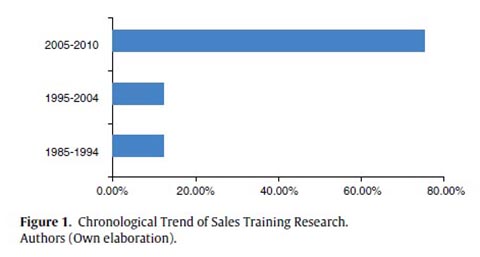
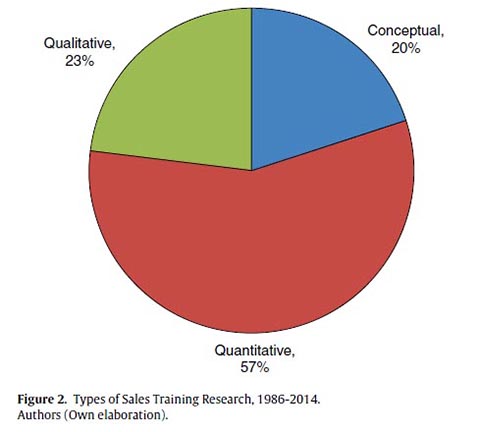
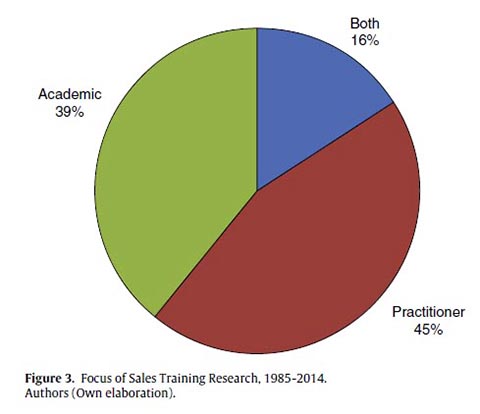
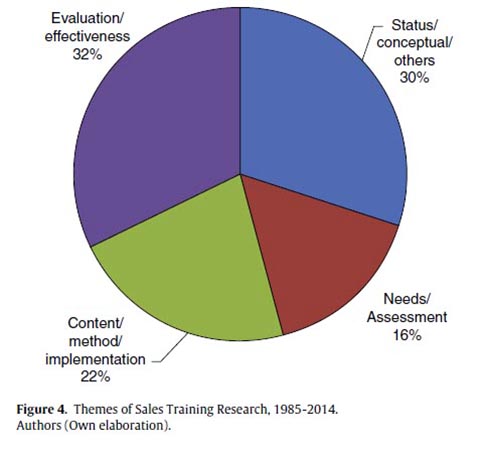
The third contribution of our review study is the identification of several methodological issues and challenges evolved in sales training research. Researching training assessment is difficult for myriad reasons; among them are access to certain data and the longitudinal nature of the sales training being evaluated. In addition research in this area is hampered by study design issues and measurement concerns. The generalizability of findings is a concern when conducting research. This concern is of primary importance when assessing sales training because there is a substantial tradeoff between the richness of data and generalizability of findings. It has been argued that case study methodology can be particularly insightful for business-to-business research (Johnston, Leach, & Liu,1999); however, generalizability requires evidence of a consistent pattern of findings across case studies. There is a severe dearth of sales training studies based on a longitudinal research design, which is especially relevant in the context of evaluation studies. Experimental design is the most powerful and advantageous way to evaluate sales training outcomes (Warr, Allan, & Birdi, 1999; as cited in Attia, Honeycutt, & Leach Mark, 2005). Failure to employ rigorous statistical techniques, such as control groups, longitudinal designs, and experimental designs, results in limited empirical research findings that are inconsistent with proposed theory development.
A fourth finding of our review is that although there are positive effects of training on organizational results, there is no clear cost-benefit relationship allowing the assessment of training effectiveness or profitability. One reason for this situation is the difficulty in finding a reliable indicator of training incidence, a fact even more complicated due to the existence of returns that are not only tangible, but also intangible. The heterogeneity of criteria among authors when evaluating these effects must be also added to this complex situation.
7. Directions for future research
Though the research on sales training has been showing positive strides in terms of the content, context as well as the quantity and quality of published studies, several more caveats and opportunities exist to aid and guide future interested scholars of this field. Future research efforts should specifically investigate how distinct selling needs and objectives differ for salespersons working in missionary, industrial, and consumer roles and how flexible the proposed model is for different sales positions. Further, most of the research oriented studies are located in North America and in Europe —the bulk of the studies being UK centric and empirical studies are even fewer—. Although most of them are descriptive and case-study based, in recent years some attempts to go into this topic in depth have been carried out (e.g., Kauffeld & Lehmann- Willenbrock, 2010). Still there is plenty of scope for further work in this area.
While organizations spend thousands of dollars to help sales teams succeed, it is the sales culture of the organization that is the key contributor or roadblock to success. This sales culture is often informally built to replicate the most influential and effective sales managers and executives. Given the rampant pace of technological advancement, future sales training research needs to be conducted incorporating the effects of social media. For example, the effect of social media in acquiring sales skills, its effect on salesperson’s approach to selling, etcetera.
The fact that the effect of human resource actions, including training, on business results depends on many other factors must be also taken into account by adopting the systemic perspective when analyzing the effect of human resource practices on business results with the help of sophisticated statistical techniques such as structural equation modeling, etcetera.
References
Abbott, J., Klein, B., Hamilton, C., & Rosenthal, A. (2009). The impact of online resilience training for sales managers on wellbeing and work performance. EJournal of Applied Psychology, 5(1), 89. [ Links ]
Alliger, G. M., & Janak, E. A. (1989). Kirkpatrick’s levels of training criteria: thirty years later. Personnel Psychology, 42, 331–342.
Alliger, G. M., Tannenbaum, S. I., Bennett, W., Traver, H., & Shotland, A. (1997). A meta- analysis of the relations among training criteria. Personnel Psychology, 50, 341–358. [ Links ]
Álvarez, Kaye., Salas, Eduardo, & Garofano Christina, M. (2004). An integrated model of training evaluation and effectiveness. Human Resource Development Review, 3, 385. [ Links ]
Aquinis, H., & Kraiger, K. (2009). Benefits of training and development for individuals and teams, organizations, and society. Annual Review of Psychology, 60, 451–474. [ Links ]
Aragón-Sánchez, Antonio, Barba-Aragón, Isabel, & Sanz-Valle, Raquel. (2003). Effects of training on business results. The International Journal of Human Resource Management, 14(6), 956–980. [ Links ]
Attia Ashraf, M., Honeycutt, Jr., & Earl, D. (2012). Measuring sales training effectiveness at the behavior and results levels using self and supervisor evaluations. Marketing Intelligence & Planning, 30(3), 324–338. [ Links ]
Attia, A. M., Honeycutt, E. D., & Jantan, M. (2006). Global sales training: In search of antecedent, mediating, and consequence variables. Industrial Marketing Management, 37(2), 181–190. [ Links ]
Attia, A. M., Honeycutt, E. D., & Leach Mark, P. (2005). A three-stage model for assessing and improving sales force training and development. Journal of Personal Selling & Sales Management, 25(3), 253–268. [ Links ]
Attia Ashraf, M., Jantan M., Asri., Atteya, Nermine, & Fakhr, Rana. (2014). Sales training: comparing multinational and domestic companies. Marketing Intelligence & Planning, 32(1), 124–138. [ Links ]
Baldwin, T. T., & Ford, J. K. (1988). Transfer of training: A review and directions for future research. Personnel Psychology, 41, 63–105. [ Links ]
Borna, S., & Sharma, D. (2011). Train your salespeople to be skilled actors: a mantra for success. Marketing Management Journal, 21(1), 160–168. [ Links ]
Chonko Lawrence, B., Howell Roy, D., & Bellenger Danny, N. (1986). Congruence in sales force evaluations: Relation to sales force perceptions of conflict and ambiguity. The Journal of Personal Selling and Sales Management, 6(1), 35–48. [ Links ]
Commeiras, Nathalie, Loubes, Anne, & Bories-Azeau, Isabelle. (2013). Identification of organizational socialization tactics: The case of sales and marketing trainees in higher education. European Management Journal, 31(2), 164–178. [ Links ]
Cravens David, W., Ingram Thomas, N., LaForge Raymond, W., & Clifford, E. (1993). Behavior-based and outcome-based salesforce control systems. Young Journal of Marketing, 57(4), 47–59. [ Links ]
Cron William, L., Marshall Greg, W., Singh, Jagdip, Spiro Rosann, L., & Sujan, Harish. (2005). Salesperson selection, training, and development: Trends, implications, and research opportunities. Journal of Personal Selling & Sales Management, 25(2), 123–136. [ Links ]
Drake-Knight, N. (2012). Training and coaching boost performance of sales staff at B&Q Model makes its mark at do-it-yourself retailer. Human Resource Management International Digest, 20(1), 14. [ Links ]
El-Ansary Adel, I. (1993). Sales force effectiveness research reveals new insights and reward-penalty patterns in sales force training. The Journal of Personal Selling and Sales Management, 13(2), 83–90. [ Links ]
Engle Robert, L., & Barnes Michael, L. (2000). Sales force automation usage, effectiveness, and cost-benefit in Germany, England and the United States. Journal of Business & Industrial Marketing, 15(4), 216–241. [ Links ]
Erffmeyer Robert, C., Russ Randall, K., & Hair Joseph, F., Jr. (1991). Needs assessment and evaluation in sales-training programs. The Journal of Personal Selling and Sales Management, 11(1), 17–30. [ Links ]
Fan Chiang, K., & Chen-Liang, C. (2006). A study to identify the training needs of life insurance sales representatives in Taiwan using the Delphi approach. International Journal of Training & Development, 10(3), 212–226. [ Links ]
Fan Chiang, K., Hui-Yin, T., & Yu Hsuang, L. (2008). The selection of life insurance sales representatives training program by using the AHP and GRA. Journal of Grey System, 20(2), 149. [ Links ]
Farrell, Seonaid, & Hakstian, A. Ralph. (2001). Improving salesforce performance: A meta-analytic investigation of the effectiveness and utility of personnel selection procedures and training interventions. Psychology & Marketing, 18(3), 281–316. [ Links ]
Ferreira Rodrigo, Rezende, & Abbad, Gardênia. (2013). Training needs assessment: Where we are and where we should go. Brazilian Academic Review, 10(1), 77–99. [ Links ]
Golterman, Jeff (2000). How will companies measure and justify spending for a CRM solution? Gartner Interactive, http://gartner11.gartnerweb.com/public/static/crm/crmqa.html [ Links ]
Gignac, G. E., Harmer, R. J., Jennings, S., & Palmer, B. R. (2012). EI training and sales performance during a corporate merger. Cross Cultural Management, 19(1), 104–116. [ Links ]
Gultek Mark, M., Dodd Tim, H., & Guydosh Raymond, M. (2006). Attitudes towards wine-service training and its influence on restaurant wine sales. International Journal of Hospitality Management, 25, 432–446. [ Links ]
Honeycutt Earl, D., Jr., Karande, Kiran, Attia, Ashraf, & Maurer Steven, D. (2001). An utility based framework for evaluating the financial impact of sales force training programs. The Journal of Personal Selling and Sales Management, 21(3), 229–238. [ Links ]
Honeycutt, E. D., & Stevenson, T. H. (1989). Evaluating sales training programs. Industrial Marketing Management, 18, 215–222. [ Links ]
Jantan, M., Asri Honeycutt, Jr., & Earl, D. (2013). Current sales training practices in the commercial retail banking industry in Malaysia. Services Marketing Quarterly, 34(1), 1–17. [ Links ]
Johnston, W. J., Leach, M. P., & Liu, A. H. (1999). Theory testing using case studies in business-to-business research. Industrial Marketing Management, 28(3), 201–213. [ Links ]
Kakavelakis, K., Felstead, A., Fuller, A., Jewson, N., & Unwin, L. (2008). Making a sales advisor: The limits of training instrumental empathy. Journal of Vocational Education and Training, 60(3), 209–221. [ Links ]
Kauffeld, S., & Lehmann-Willenbrock, N. (2010). Sales training: Effects of spaced practice on training transfer. Journal of European Industrial Training, 34(1), 23–37. [ Links ]
Kirkpatrick, D. L. (1994). Evaluating training programs. San Francisco: Berrett-Koehler Publishers, Inc. [ Links ] Krafft, Manfred. (1999). An empirical investigation of the antecedents of sales force control. Journal of Marketing, 63(3), 120–134. 70 V.L. [ Links ]
Lassk, F. G., Ingram, T. N., Kraus, F., & Di Mascio, R. (2012). The future of sales training: Challenges and related research questions. Journal of Personal Selling & Sales Management, 32(1), 141–154. [ Links ]
Little, B. (2012). Identifying key trends in sales–from a training perspective. Industrial & Commercial Training, 44(2), 103–108. [ Links ]
Lupton Robert, A., Weiss John, E., & Peterson Robin, T. (1999). Sales Training Evaluation Model (STEM): A conceptual framework. Industrial Marketing Management, 28, 73–86. [ Links ]
Pelham, A. (2009). The impact of industry and training influences on salesforce consulting time and consulting effectiveness. Journal of Business & Industrial Marketing, 24(7/8), 575–584. [ Links ]
Pelham, A., & Kravitz, P. (2008). An Exploratory Study of the Influence of Sales Training Content and Salesperson Evaluation on Salesperson Adaptive Selling, Customer Orientation, Listening, and Consulting Behaviors. Journal of Strategic Marketing, 16(5), 413–435. [ Links ]
Peltzer, K., Ramlagan, S., & Gliksman, L. (2006). Responsible alcoholic beverages sales and services training intervention in Cape Town: A pilot study. Journal of Psychology in Africa, 16(1), 45. [ Links ]
Pettijohn, L. S., Pettijohn, C. E., & Taylor, A. J. (2009). Retail sales training: activities and effects on job satisfaction, organizational commitment, turnover and customer orientation. Marketing Management Journal, 19(1), 46–57. [ Links ]
Piercy Nigel, F., Cravens David, W., & Morgan Neil, A. (1998). Sales force performance and behaviour-based management processes in business-to-business sales organizations. European Journal of Marketing, 32(1), 79–100. [ Links ]
Pollitt, David. (2012). Sales take off at Midlands Co-operative Travel X-Factor training boosts customer service. Human Resource Management International Digest, 20(1), 30. [ Links ]
Pollitt, David. (2011a). Magazine business turns a new page with training for sales team: Investment in employees boosts profitability and morale. Human Resource Management International Digest, 19(6), 20. [ Links ]
Pollitt, David. (2011b). Training helps salesforce to sparkle: Program develops listening skills at Jeweler. Human Resource Management International Digest, 19(1), 15. [ Links ]
Pollitt, David. (2011c). Training delivers higher sales for Pitney Bowes: Revenues, productivity and order values improve at franking and mail stream company. Human Resource Management International Digest, 19(1), 23. [ Links ]
Pollitt, David. (2010a). Jedi masters are the model of maturity at Mongoose Media: High-speed sales training defies the recession. Human Resource Management International Digest, 18(6), 15. [ Links ]
Pollitt, David. (2010b). BT Business Sales dials up a customer-focused coaching culture: Program combines new technology with tailored training. Human Resource Management International Digest, 18(4), 7. [ Links ]
Pollitt, David. (2010c). Evaluation of sales training programmes in Croatian companies. International Journal of Management Cases, 12(2), 718. [ Links ]
Pollitt, David. (2007). Training transforms culture and boosts growth at B Braun Medical: Sales team moves to a more "consultative" approach. Human Resource Management International Digest, 15(5), 26. [ Links ]
Pollitt, David. (2006). Saint-Gobain Glass gains clear benefits from training: Impact felt on productivity, quality, sales and safety. Human Resource Management International Digest, 14(5), 13. [ Links ]
Powers, T. L., DeCarlo, T. E., & Gupte, G. (2010). An update on the status of sales management training. Journal of Personal Selling & Sales Management, 30(4), 319–326. [ Links ]
Rao, V. (2010). Training sales professionals: Challenges in the 21st Century. IUP Journal of Soft Skills, 4(1/2), 68–74. [ Links ]
Ricks, J. M., Williams, J. A., & Weeks, W. A. (2008). Sales trainer roles, competencies, skills, and behaviors: A case study. Industrial Marketing Management, 37(5), 593–609. [ Links ]
Román, Sergio, Ruiz, Salvador, & Munuera José, Luis. (2002). The effects of sales training on sales force activity. European Journal of Marketing, 36(11), 1344–1366. [ Links ]
Russell, J. S., Terborg, J. R., & Powers, M. L. (1985). Organizational performance and organizational level training and support. Personnel Psychology, 38, 849–863. [ Links ]
Sarin, S., Sego, T., Kohli, A. K., & Challagalla, G. (2010). Characteristics that enhance training effectiveness in implementing technological change in sales strategy: a field-based exploratory study. Journal of Personal Selling & Sales Management, 30(2), 143–156. [ Links ]
Siguaw Judy, A., Brown, Gene, & Widing Robert, E., II. (1994). The influence of the market orientation of the firm on sales force behavior and attitudes. Journal of Marketing Research, 31(1), 106–116.
Schwepker, J. H., & Good, D. J. (2007). Sales management’s influence on employment and training in developing an ethical sales force. Journal of Personal Selling & Sales Management, 27(4), 325–339.
Shepherd, C., Gordon, G. L., Ridnour, R. E., Weilbaker, D. C., & Lambert, B. (2011). Sales manager training practices in small and large firms. American Journal of Business, 26(2), 92–117. [ Links ]
Tan, Kim, & Newman, Eric. (2012). Sales force training evaluation. Journal of Business & Economics Research, 10(2). [ Links ]
Tan, Kim, & Newman, Eric. (2013). The evaluation of sales force training in retail organizations.;1; A test of Kirkpatrick’s Four-level Model. International Journal of Management, 30(2).
Toomey, T. L., Erickson, D. J., Lenk, K. M., Kilian, G. R., Perry, C. L., & Wagenaar, A. C. (2008). A randomized trial to evaluate a management training program to prevent illegal alcohol sales. Addiction, 103(3), 405–413. [ Links ]
Uduji Joseph, I. (2013). Apathetic attitude of the drug reps: A hindrance to sales training in the health care industry in Nigeria. European Journal of Business and Management, 5(8). [ Links ]
Vadi, M., & Suuroja, M. (2006). Training retail sales personnel in transition economies: Applying a model of customer-oriented communication. Journal of Retailing & Consumer Services, 13(5), 339–349. [ Links ]
Valentine, S. (2009). Ethics training, ethical context, and sales and marketing professionals’ satisfaction with supervisors and coworkers. Journal of Personal Selling & Sales Management, 29(3), 227–242.
Zoltners, A., Sinha, P. K., & Lorimer, S. E. (2008). Sales force effectiveness: A framework for researchers and practitioners. Journal of Personal Selling and Sales Management, 28(2), 115–131. [ Links ]
Corresponding author:
Professors of Marketing in the Department of Business Administration, University of Delaware, Newark, USA. VijayLakshmi Singh is a Doctoral Scholar, Indian Institute of Management, Ahmedabad, India. Please contact Professor Ajay Manrai at, Tel.: +302 831 1770; fax: +302 831 4196.
E-mail address: manraia@udel.edu
* For Any inquiries pertaining to this paper. The authors wish to thank the reviewers and the editor for their valuable comments on the earlier versions of this paper.
Received 16 May 2014
Accepted 13 January 2015



















